World War II brought turmoil and conflict globally. The Philippines especially felt this during the Japanese occupation. A debated topic is the existence of Japanese 5th columnists in the Philippines. We question if they truly existed and the impact they had during and after the war.
This article aims to uncover the truth about Japanese 5th columnists in WW2 and how they affected the Philippines. We’ll look at history, evidence, and stories from civilians and resistance groups. This exploration will challenge what we think we know and shine a light on a part of history still influencing us today.
Key Takeaways:
- Japanese 5th columnists in the Philippines during World War II have been the subject of debate and speculation.
- Exploring historical accounts and evidence can help uncover the truth behind their existence and activities.
- The impact of Japanese 5th columnists on the Philippines during the war is a significant aspect of understanding the country’s history.
- Examining the experiences of civilians and resistance groups can provide insights into their interactions and influence.
- Unraveling the truth about Japanese 5th columnists challenges common beliefs and helps shape our understanding of World War II.
The Onset of World War II in the Pacific and the Philippines at the Crossroads
The start of World War II in the Pacific meant big changes for the Philippines. This country was key to many trade routes and was of strategic importance. During this time, the Japanese occupation had a deep and lasting effect on the Philippines and its people.
The Japanese took control of the Philippines on December 8, 1941. This was just hours after the attack on Pearl Harbor. They invaded, targeting cities and key military spots. Even though General Douglas MacArthur led a strong defense, the Japanese were too strong. The Philippines fell to them.
The occupation brought major changes across the Philippine government, economy, society, and culture. The Japanese ruled with a heavy hand, setting curfews and censoring information. They enforced forced labor and took resources for their own use.
In the face of these hardships, Filipinos showed great resilience. They formed guerilla groups to resist and support the Allied forces. This resistance was often met with harsh punishments, leading to many deaths.
The Impact on the Philippines
The Japanese rule affected the Philippines deeply in many ways:
- Political: The Philippines lost full control under the Japanese. A puppet government, lead by President Jose P. Laurel, was set up. This was to make the occupation seem legitimate.
- Economic: Japan’s use of the Philippines’ resources hit hard. Forced work and natural resource use caused poverty and hunger for many Filipinos.
- Social and Cultural: Life and traditions were heavily disrupted. Many Filipinos faced severe abuses, influencing their cultural identity. They struggled with issues of collaboration, resistance, and survival.
- Educational: Education in the Philippines changed a lot under Japanese rule. The curriculum focused on Japan and discouraged Filipino history and culture.
The Japanese occupation’s effects are still felt in the Philippines today. This dark time in history marks the country and its people. The Philippines continues to work through these memories, helping shape its future.
| Japanese Occupation | Impact on the Philippines |
|---|---|
| Political loss of sovereignty | Complete loss of sovereignty, establishment of a puppet government |
| Economic exploitation | Forced labor, resource extraction, widespread poverty |
| Social and Cultural disruption | Human rights abuses, reconfiguration of Filipino identity |
| Educational changes | Changes in curriculum, suppression of Filipino history and culture |
Unraveling the Concept of Fifth Columnists
To grasp the full scope of fifth columnists during World War II, we must look into their beginnings. It’s vital to see how they fit into global conflicts. Their actions ranged from the Spanish Civil War to conflicts in Europe and Asia, shaping history’s course.
Origins and Definition: From Spanish Civil War to Global War
The term “fifth columnists” was coined during the Spanish Civil War, thanks to General Emilio Mola. He mentioned four advancing columns and a fifth, hidden one. This idea of working from within became linked with spying and sabotage activities.
World War II saw the term evolve. It now included people and groups secretly working in occupied areas. They often helped invaders or spied. Their goal was to weaken resistance by creating chaos from within.
Fifth Column Movements Across Europe and Asia
Fifth column movements cropped up in Europe and Asia, supported by different reasons. These were unique to each place but shared a common goal: to help invaders. Tensions, ideals, and personal benefits fueled their actions.
They did many things, like collecting info, sabotage, spreading lies, and aiding occupiers. Their targets were vital areas like government spots, the military, communications, and the normal people. This aimed to have the biggest effect and make it harder to fight back.
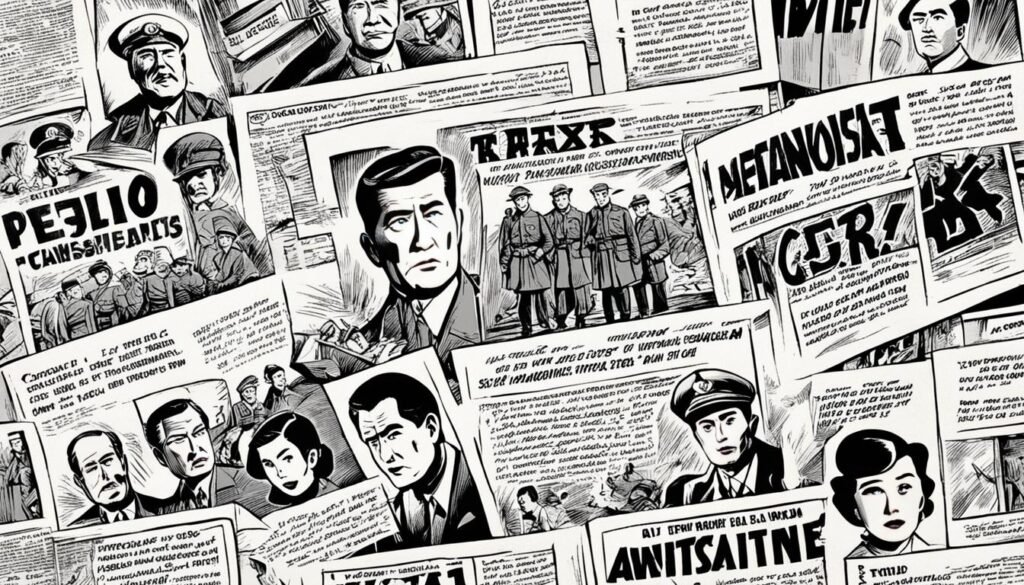
- The Filiki Eteria: Founded in Greece in the early 19th century, it sparked nationalist feelings. It fought the Ottoman Empire, eventually leading to Greece’s independence in 1821.
- The Norwegian Quisling Movement: Vidkun Quisling led this pro-Nazi group in Nazi-occupied Norway. They set up a puppet government, helping Nazis control the country.
- The Indian National Army: Led by Subhas Chandra Bose, it aimed to free India from the British with Japan’s help. They fought as a united force against British rule in India.
- The Zhongshan Society: A Chinese group fighting against Japan’s occupation. They used guerrilla tactics, espionage, and sabotage. They were vital in resisting Japanese rule.
These cases show the wide range of fifth column movements. Understanding their start and impact in World War II is crucial.
Japanese 5th Columnists
In World War II, Japanese 5th columnists were key as spies for Japan. They worked to sabotage and get info to Japan. This was a big deal and impacted the war’s progress a lot.
They used hidden methods, blending in with locals and staying secret. The main goal was to find out about enemies and help Japan by sharing this info. They joined resistance groups to learn more.
These spies were trained very well. They took on fake names and sent hidden messages to their leaders. They were good at getting info quietly and giving it to their bosses secretly.
Infiltration was a big part of their plan. They would become part of Filipino groups to gather intel easier. They became trusted members and it was hard for others to find out their real mission.
They also got help from people within these communities. They would use problems or fights to turn people to their side. These helpers would give info or help them operate.
“The Japanese 5th columnists’ work in WWII made a big difference in the Philippines. Their spying and sabotage threatened safety and hindered the resistance. Finding and stopping them was a major goal for local and allied troops.”
Stopping these spies was tough. It needed careful intel work and working together by many groups. Turning some spies against Japan, undercover work, and keeping secrets safe were all key.
Table:
| Japanese 5th Columnists | Description |
|---|---|
| Role | Spies and agents for Japan |
| Tactics | Infiltration, recruitment of local collaborators |
| Objectives | Gathering intelligence, sabotage enemy operations |
| Impact | Threat to national security, disadvantaged resistance movement |
The work of Japanese 5th columnists shows how spying in wars is very tricky. Their efforts had a big and lasting effect on the Philippines. It reminds us to always be watchful against threats.
The Historical Context of Japan’s Occupancy in the Philippines
To truly understand Japan’s time in the Philippines during WW2, we must see the big picture. The invasion was a key moment in the war, bringing years of occupation. This era caused widespread suffering among the Filipino people.
Philippines Under Siege: The Timeline of Japanese Invasion
The Japanese landed in the Philippines on December 8, 1941, after attacking Pearl Harbor. They aimed for the American military spots, like the naval base in Cavite and airfields in Manila. Soon, they overcame the unready American and Filipino troops, making Manila an ‘open city’ to lessen damage.
By January 2, 1942, Manila was under Japanese control. They set up their own government there, called the Philippine Executive Commission. This was led by Filipino Jose Laurel. It was done to make their control seem legitimate.
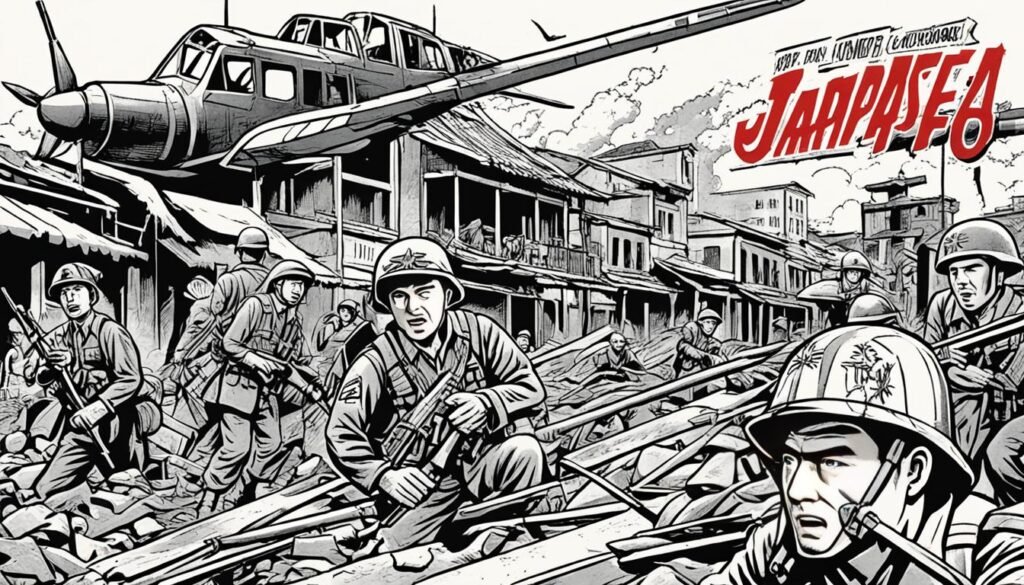
Life During the Occupation: Civilian Experiences and Atrocities
Life for Filipinos under Japanese rule was very hard. The Japanese controlled everything and used the country’s resources for their benefit.
People didn’t have enough food because the Japanese took it away and rationed what was left. Many went hungry. They also forced people to work on buildings and in their businesses. This was very tough for everyone.
People also witnessed and suffered from terrible acts. There were killings, sexual assaults, and tortures by the Japanese. These actions deeply affected the Filipino people for years to come.
The Filipinos, despite everything, showed great courage. They resisted the Japanese, forming secret groups and fighting back. Their efforts were crucial in freeing the Philippines later on.
| Timeline of Japanese Invasion in the Philippines | Events |
|---|---|
| December 8, 1941 | Japanese invasion begins, targeting American military installations |
| December 25, 1941 | Manila declared an “open city” by General Douglas MacArthur |
| January 2, 1942 | Japanese capture Manila and establish their administrative center |
| Throughout the Occupation | Forced labor, economic exploitation, and atrocities against civilians |
| 1944-1945 | Filipino guerrilla forces and allied troops liberate the Philippines |
Assessing the Evidence of Japanese 5th Column Activities in the Philippines
Talking about Japanese 5th columnists in the Philippines during World War II, it’s key to look at their activities. The Makapilis played a big role. This group of Filipinos helped the Japanese forces. We learn a lot about their involvement through case studies.
The Role of Makapilis: Fact or Fiction?
The Makapilis were Filipinos who worked with the Japanese during World War II. They did things like gathering info and helping in military operations. But, we’re not sure about the depth of their efforts.
Some think they did it for their country. They believed it could help the Philippines become independent. Others think they were traitors. They say the Makapilis betrayed their people for selfish reasons.
Despite different views, the Makapilis had a part in the Japanese rule of Philippines. Knowing why they did what they did helps us understand wartime cooperation. It’s part of the complex story of that time.
Case Studies: Alleged Fifth Column Incidents
Let’s look at some case studies to understand more about Japanese 5th column activities. One is about a Japanese agent named Kazuo Kaneshiro. He spied in the Philippines, gathering info on American military sites for the Japanese. He got caught and shared intel, showing the Japanese spy network.
Another case is the sinking of the USS Panay by Japanese planes in 1937. This attack showed the danger faced by Americans and Europeans in the area. It made people suspect the presence of fifth column activities. People wondered if locals helped the Japanese with intel or support.
Case studies help us see how the alleged fifth column incidents played out in the Philippines. These stories are key historical events. They show us a bigger picture of war time. They give insight into cooperation and espionage.
To understand Japanese 5th column activities in the Philippines, we need to look closely at Makapilis and analyzed case studies. Understanding their roles shows us the complicated nature of war time cooperation. It helps us see what it meant for the Filipinos.
Learn more about the experiences of Japanese Americans during World War II.
Resistance and Resilience: The Filipino Guerrillas’ Response
During the Japanese rule, Filipino guerrillas showed great bravery. They stood against oppressive forces, fighting for their homeland. Their actions demonstrated true resistance and resilience.
The Formation of Underground Movements
Filipino guerrillas worked secretly, forming hidden groups for sabotage and intelligence. They were made up of everyday people. These included former soldiers, students, farmers, and professionals. They were all united by their love for their country and their will to fight for its freedom.
These groups set up secret communication lines, hiding places, and training sites. They used the tough terrains and far-off places of the Philippines for their operations. Their surprise attacks and strategy kept the enemy forces on edge.

Allied Cooperation and Support for Resistance Groups
Allied forces saw the key role of the guerrillas. They gave them vital assistance. This support included training and providing weapons. It aimed to boost the guerrillas’ efforts against the Japanese.
The United States and its partners worked closely with the Filipino fighters. They joined forces to plan the liberation of the Philippines. This teamwork helped achieve military successes against the adversary.
The morale of the fighters was lifted by knowing the allies were behind them. This support encouraged the guerrillas, making them more determined to succeed.
The combined fight of the guerrillas and the allies grew strong. Together, they paved the path to free the Philippines from Japanese rule.
For more about the Filipino guerrillas and their brave stand, you can visit this article.
Impact of Propaganda on Perceptions of Fifth Columnists
In wartime, propaganda changes how we view potential traitors aiding the enemy. The media is very influential at shaping what we think about these people. It uses strong messages to affect our feelings and understanding.
Media Influence During War
The media greatly influences what we think about those who might help the enemy. It shares news and stories that make us see them as either good or bad. This can lead to the spreading of wrong ideas and unfair views.
Psychological Warfare: Discerning Truth from Manipulation
Psychological warfare confuses us. It uses lies and plays with our emotions to make us see alleged traitors in a specific way. This tactic aims to get us to follow a certain belief or goal.
Radio was a big tool for this during World War II. The Axis powers used it to spread messages against the allied forces and those who might help them. These broadcasts shaped how we saw these people, sometimes in a very negative light.
It’s crucial to think about what we hear or see during a war. We should question the information and not easily believe everything. By being aware of how propaganda works, we can better form our own opinions about fifth columnists.
For more on how propaganda and the media affect us in war, you can check out this link: PBS – Impact of Propaganda and Media Influence.
Japanese Military Strategy and its Implementation in the Philippines
During World War II, the Japanese used many strategies to control areas, including the Philippines. The zonification technique was key in this control over people.
Zonification divided cities and towns into different zones with specific rules. Japanese forces controlled the civilian population tightly with this method. It helped prevent people from going against Japan.
They also set up military police units in the Philippines. These units ensured all rules were followed and stopped any fighting back. The police helped the Japanese keep their power by making sure people obeyed.
The military police’s job often caused problems with the people. They enforced Japanese laws by arresting and punishing those against them. This made Japan’s control stronger over the Philippines during the war.
Studying Japan’s military strategy in the Philippines shows how power worked during World War II. It explains how Japan kept control and fought off resistance.
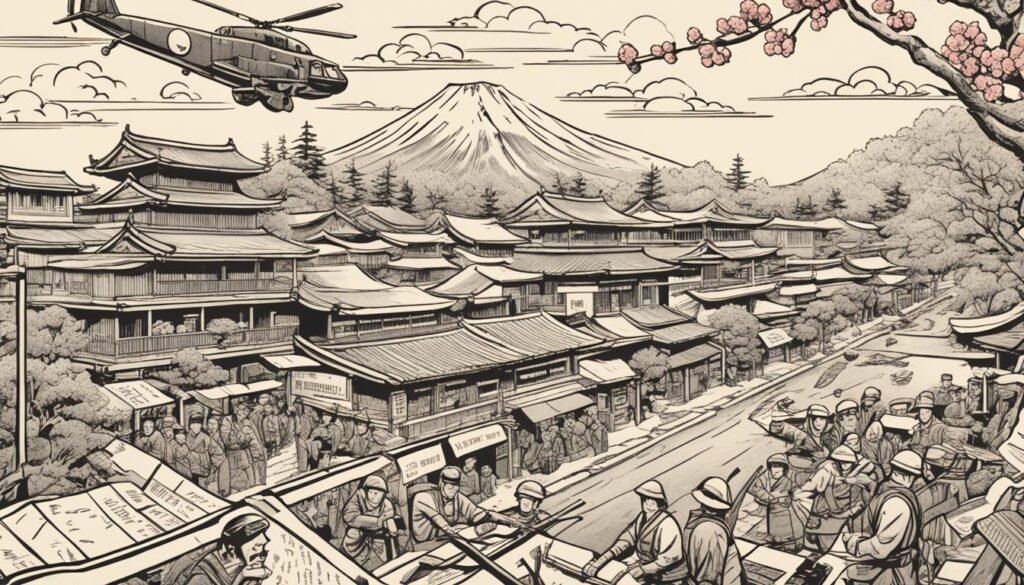
Post-War Legacies and the Search for Truth
The Japanese occupation of the Philippines during World War II left lasting effects. The Bataan Death March, in April 1942, became a dark stain in Filipino history. It was a forced walk of about 65 miles, where Filipino and American prisoners faced brutal treatment.
During the march from Bataan to Capas, up to 18,000 prisoners died. This grim event stands out for its inhumanity. It highlights the awful acts of war committed by the Japanese.
Today, the Bataan Death March remains a key moment of suffering in Filipino history. Survivors and their relatives push for apologies and recognition. They want the wrongs of the past to be acknowledged and addressed.
The fight for justice has been a major goal for the Filipino people for many years. They want to force for what happened during the Bataan Death March. Seeking reparations is seen as a way to provide some peace to victims and their families.
| Post-War Legacies | Bataan Death March | Reparations and Recognition |
|---|---|---|
| Impact on the Philippines’ history and identity | Gruesome forced march of prisoners of war | Seeking justice and closure for victims |
| Legacy of wartime atrocities and human rights abuses | Symbol of Japanese wartime atrocities | Addressing damages and acknowledging survivors |
| Remembered as a solemn reminder of the suffering | Painful chapter in the collective memory | Long-standing battle for reparations |
The Bataan Death March and its aftermath are vital in remembering Filipino sacrifices. They show the importance of seeking truth and justice. These events not only mark a tragedy but also the resilience of the Filipino people. Understanding and acknowledging these legacies is key to moving forward and remembering a difficult part of the country’s past.
World Response to Alleged Japanese Fifth Column Tactics
The alleged Japanese fifth column tactics in World War II caught the world’s eye. Governments and agencies were watchful of these alleged spies. They were seen as a threat to many countries’ safety.
Internationally, the idea of Japanese spies startled many. This was especially true for places like the Philippines. The world knew it needed to fight back against Japanese spying and sabotage.
There was a big push to tell people about the spies’ methods. Governments worked together to stop Japanese spies from causing harm. They shared what they knew to keep themselves safe.
A good example of this teamwork was when the Allies set up a group to fight against Japanese spies. This made it easier to find and stop the spies.
The media also helped get the word out. Stories from affected areas showed how bad the spies’ actions really were. This was a big help in getting everyone on board to fight these tactics.
The world coming together to fight the Japanese fifth column showed the power of teamwork. It’s a lesson in being ready and working with others to stay safe during tough times.
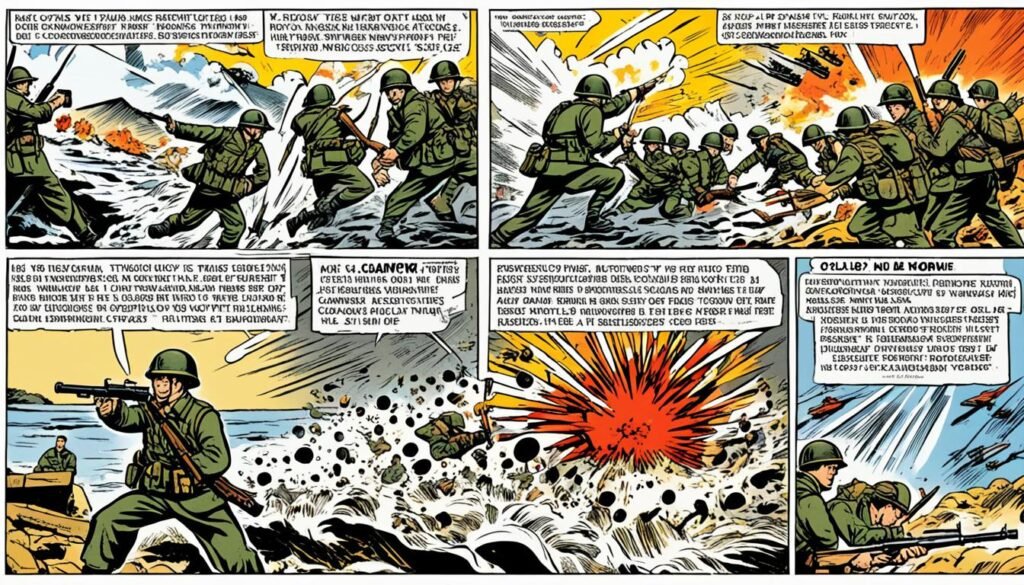
International Response to Alleged Japanese Fifth Column Tactics
| Country | Response |
|---|---|
| United States | Strengthened counterintelligence efforts and implemented stricter security protocols |
| Australia | Formed special task forces to investigate and neutralize Japanese espionage networks |
| China | Collaborated with Allied forces to gather intelligence and disrupt Japanese fifth column activities |
| United Kingdom | Implemented surveillance measures and conducted operations to dismantle Japanese spy rings |
| Philippines | Established networks of resistance fighters and worked closely with the United States in intelligence-sharing |
The table above shows how nations responded to Japanese fifth column threats. Each country worked in ways that fit its situation. Together, they focused on gathering and sharing information and working with allies.
Evaluating Collaborators: Victims, Villains, or Survivalists?
The period of Japanese rule in the Philippines sparked tough choices for many. The mention of ‘collaborators’ today still stirs up complex feelings. Filipinos had to make hard decisions under a strong-arm regime. One group, the Makapili, highlights just how tricky this time was for people everywhere in the country.
Moral Dilemmas Faced by Filipinos During Occupation
The time under Japanese rule tested the morals of many in the Philippines. People often had to pick between helping the occupiers or opposing them. This choice came with the fear of what might happen to not only themselves but to their loved ones. So, when we talk about ‘collaborators,’ we need to consider the very difficult situations they were in. We should remember that they were weighing their own survival against doing what they felt was right.
The Makapili: Betrayers or Another Facet of War?
The Makapili issue is a particularly divisive part of this history. This group was made up of Filipinos who sided with the Japanese army. Their name, short for “Makabayan na Kawal ng Pilipinas” (meaning Patriotic Soldiers of the Philippines), suggests they believed they were serving their country. But their actions were seen by many as betrayal.
The Makapili took different roles, from helping as auxiliaries to sharing information and even fighting. Some might have truly believed in their cause. For others, fear and the urge to survive might have pushed them.
The Makapili are still a touchy subject today. Some see them as outright traitors. Others find pity in their situation, suggesting they had no good choices. Looking closer at why they did what they did opens a door to understanding the moral shadows of war.
Studying the collaborators’ stories helps us see the many shades of wartime actions. As we delve into this dark chapter of Philippine history, we try to understand the pressure these people were under. In this search for truth, we hope to get a clearer, more human picture of this complicated era.
Challenges in Documenting World War II in the Philippines
Documenting World War II in the Philippines has many hurdles for historians and researchers. These hurdles include different historical stories and problems getting to archives. Also, keeping records in good condition is hard. Overcoming these barriers helps us really know the war’s impact on the Philippines.
Divergence in Historical Accounts
One big issue is the many different stories about World War II in the Philippines. War’s complexities and time have made tales conflict. This makes finding the truth tough. Historians must carefully check many sources to find what really happened.
Access to Archives and Preservation Efforts
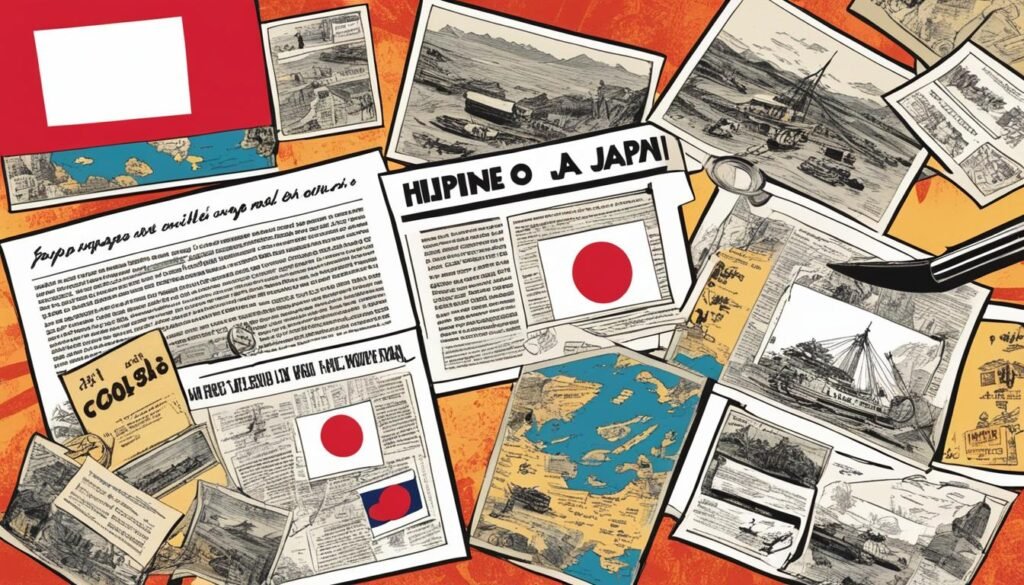
Getting to historical materials can be a big challenge. The Philippines has lots of important papers and memories from the war. But, finding these documents is not easy because they’re in many places. Also, not enough money and resources mean these records often go unkept.
Yet, historians and researchers work hard to find and save these stories from World War II in the Philippines. With better teamwork and new technology, they aim to make history more complete. Overcoming these obstacles can lead to a clearer view of the war and its lasting effects on the Philippines and its people.
Lingering Myths vs. Documented Realities of Japanese 5th Columnists
The talk about Japanese 5th columnists from World War II is still clouded in mystery and myths. Many rumors and myths have twisted what really happened in that time. But, detailed research has uncovered the facts, leading us to a better understanding of what Japanese 5th columnists truly did during the war.
Myth-Busting: Separating Fact from Fiction
Myth-busting looks at common beliefs closely and compares them against solid evidence. Take, for example, the myth that Japanese 5th columnists held a strong power over people in occupied lands. The truth, though, is not as clear-cut.
We now know that, while these 5th columnists did operate, their effects were not as big as some claim. They faced many obstacles, from not speaking the local languages to cultural barriers. This made their efforts much less successful than thought, possibly unable to sway entire groups of local people.
What’s more, most supposed activities of the Japanese 5th columnists were not widespread at all. These were more likely just a few occurrences or misunderstandings. The real details come from historical records and stories from the people who experienced those times.
Analyzing Allegations: The Role of Historians and Researchers
To really understand what Japanese 5th columnists did, historians and experts need to dive deep. They look at original documents, accounts from individuals, and military papers. Their goal is to find the facts hidden within all the stories.
The work of these historians is detailed and critical. They must check the truth of every source, looking at different pieces of information to see what makes sense. This hard work helps pull apart the myths and bring the real stories to light.
The National World War II Museum is a key place for these history detectives. It holds valuable information that aids in their quest to find the truth about Japanese 5th columnists and the war.
| Myths | Realities |
|---|---|
| Japanese 5th columnists were a highly organized and influential force within occupied territories. | The actual impact and influence of Japanese 5th columnists were often limited and exaggerated. |
| Japanese 5th columnists had extensive control over local populations. | Language barriers, cultural differences, and counterintelligence efforts hindered the effectiveness of Japanese 5th columnists. |
| Alleged instances of Japanese 5th column activities were widespread and indicative of large-scale operations. | Many alleged instances were isolated incidents or the result of paranoia and suspicion. |
Education and War Memory in Contemporary Philippines
Today, in the Philippines, education is key to telling our story and remembering big events like World War II. Teaching about the war in school ensures young people understand its effects. We will talk about why it’s important to learn about the war and its lasting effects.
Curriculum Inclusion of WW2 History
Studying WW2 lets students see what their ancestors faced during the war. It teaches them about the bravery and strength of Filipinos. Subjects include when the war happened, what civilians and soldiers went through, and the role of guerrillas.
Learning about the war helps students think critically and feel connected to their country. They explore different views on the war and discuss its impacts. This builds their skills to make good choices as citizens.
Transgenerational Trauma and Its Relevance Today
Transgenerational trauma shows how past horrors can still affect families today. The wartime suffering of Filipinos has left deep scars. It’s important to understand how these experiences shape the present.
Dealing with transgenerational trauma is a big issue today. By talking about it, families and communities can start to heal. Education offers a way to face and understand the pain of war. It can create a space where students can talk about their feelings and grow stronger.
In the end, teaching about WW2 helps Filipinos know and heal from the past. It ensures the memories of sacrifice are never forgotten. By dealing with transgenerational trauma, the Philippines can become a stronger, more united nation.

Conclusion
In conclusion, the role of Japanese 5th columnists in WWII’s impact on the Philippines is complex and debatable. We’ve looked at their actions, the response of Filipino guerrillas, and the role of propaganda. Also, we discussed the challenges in understanding their true impact.
The Japanese takeover of the Philippines greatly affected the nation and its people. The impact of 5th columnists is real but not fully understood. People are still debating the roles of groups like the Makapilis and their members.
We must continue to accurately study this historical period. It’s essential to separate facts from myths and trust well-researched findings. Historians and scholars play a vital role in revealing the true story. This helps us learn from history and make better choices in the future.
For a deeper look at this topic, check out the study by MDPI. It provides valuable insights into 5th columnists and their effects in the Philippines during WWII.
FAQ
Were there really 5th columnists in Japan during World War II?
Yes, Japan had 5th columnists during World War II. These individuals or groups worked as spies and did sabotage for Japan. Their goal was to gather intel and disrupt activities.
How did Japanese 5th columnists operate within the Philippines?
In the Philippines, Japanese 5th columnists snuck into local areas. They spied, and did sabotage and espionage for Japan. This was to help Japan’s occupation by weakening Filipino resistance.
What was the role of the Makapilis during the Japanese occupation of the Philippines?
The Makapilis helped Japan in the Philippines. They were a group that informed, enforced, and worked with Japanese forces. Today, people still talk and argue about their actions.
What evidence is there of Japanese 5th column activities in the Philippines?
Reports show Japanese 5th column work in the Philippines. Stories of spying, sabotage, and helping Japan come from people who supported Japan. We learn about these from case studies and history records.
How did Filipino guerrillas respond to Japanese occupation?
Filipino guerrillas fought back by going into hiding and attacking the Japanese. They also helped the Allies. Their actions were a key part of resisting Japan during that time.
What impact did propaganda have on perceptions of 5th columnists?
Propaganda shaped how people saw 5th columnists. During the war, news and stories either made them look very bad or tried to say they were not so bad. This could change what people thought about them.
How did Japanese military strategy affect the civilian population in the Philippines?
Japan used zonification in the Philippines to control where people could go. They set rules enforced by military police. Their interactions with civilians were sometimes peaceful and sometimes not.
What were the post-war legacies of Japanese occupation in the Philippines?
After the war, the Philippines faced many issues like the harsh Bataan Death March. Survivors had a tough time. People also fought for Japan to make up for the bad things that happened during their occupation.
How was the alleged Japanese 5th column tactics viewed by other countries?
Different countries saw Japanese 5th column tactics in their own way. Some believed there was a real danger, while others thought it might have been just to scare people or make things seem worse.
What challenges exist in documenting World War II in the Philippines?
Documenting the war in the Philippines is hard because stories are not always the same. It’s tough to get into archives. Also, there’s a lot of work going on to keep history records safe and clear.
What are some lingering myths surrounding Japanese 5th columnists?
Stories about Japanese 5th columnists have gotten stretched over time. Some talk about big plans and doubt what really happened. These stories sometimes mix up what we know about what they really did.
How does education in the Philippines address the history of World War II?
The way schools teach about World War II changes. They focus on different things and use different methods. The goal is to make sure students learn about the war and its effects on the country.
Source Links
- https://www.nationalww2museum.org/war/articles/liberation-of-philippines-cecilia-gaerlan
- https://warfarehistorynetwork.com/article/japanese-attack-on-the-philippines-the-other-pearl-harbor/
- https://en.wikipedia.org/wiki/Fifth_column

